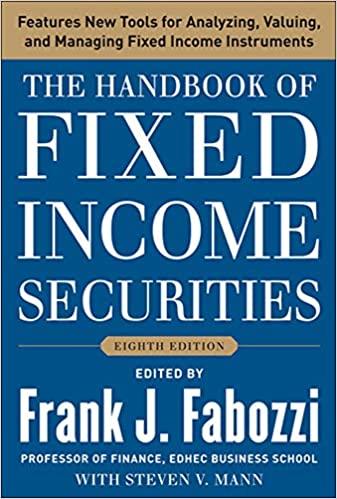Question
1. Suppose your firm is considering investing in a project with the cash flows shown below, that the required rate of return on projects of
1.
| Suppose your firm is considering investing in a project with the cash flows shown below, that the required rate of return on projects of this risk class is 7 percent, and that the maximum allowable payback and discounted payback statistics for the project are 3.5 and 4.5 years, respectively. |
| Time: | 0 | 1 | 2 | 3 | 4 | 5 | 6 |
| Cash flow | $4,800 | $1,210 | $2,410 | $1,610 | $1,530 | $1,410 | $1,210 |
| Use the payback decision rule to evaluate this project. (Round your answer to 2 decimal places.) |
| Payback | years |
2.
| Suppose your firm is considering investing in a project with the cash flows shown below, that the required rate of return on projects of this risk class is 8 percent, and that the maximum allowable payback and discounted payback statistics for the project are 3.5 and 4.5 years, respectively. |
| Time: | 0 | 1 | 2 | 3 | 4 | 5 | 6 |
| Cash flow | $7,700 | $1,110 | $2,310 | $1,510 | $1,510 | $1,310 | $1,110 |
| Use the IRR decision rule to evaluate this project. (Negative amount should be indicated by a minus sign. Round your answer to 2 decimal places.) |
| IRR | % |
3.
| KADS, Inc., has spent $360,000 on research to develop a new computer game. The firm is planning to spend $160,000 on a machine to produce the new game. Shipping and installation costs of the machine will be capitalized and depreciated; they total $46,000. The machine has an expected life of three years, a $71,000 estimated resale value, and falls under the MACRS 7-year class life. Revenue from the new game is expected to be $560,000 per year, with costs of $210,000 per year. The firm has a tax rate of 40 percent, an opportunity cost of capital of 13 percent, and it expects net working capital to increase by $80,000 at the beginning of the project. |
| What will the cash flows for this project be? (Negative amounts should be indicated by a minus sign. Round your answers to 2 decimal places.) |
| Year | 0 | 1 | 2 | 3 | ||||
| FCF | $ | $ | $ | $ | ||||
4.
| Your firm needs a computerized machine tool lathe which costs $49,000 and requires $11,900 in maintenance for each year of its 3-year life. After three years, this machine will be replaced. The machine falls into the MACRS 3-year class life category. Assume a tax rate of 34 percent and a discount rate of 13 percent. |
| If the lathe can be sold for $4,900 at the end of year 3, what is the after-tax salvage value? (Round your answer to 2 decimal places.) |
| Salvage value after tax | $ |
5.
| You are evaluating a project for The Ultimate recreational tennis racket, guaranteed to correct that wimpy backhand. You estimate the sales price of The Ultimate to be $360 per unit and sales volume to be 1,000 units in year 1; 1,250 units in year 2; and 1,325 units in year 3. The project has a 3-year life. Variable costs amount to $205 per unit and fixed costs are $100,000 per year. The project requires an initial investment of $153,000 in assets, which will be depreciated straight-line to zero over the 3-year project life. The actual market value of these assets at the end of year 3 is expected to be $31,000. NWC requirements at the beginning of each year will be approximately 20 percent of the projected sales during the coming year. The tax rate is 39 percent and the required return on the project is 12 percent. (Use SL depreciation table) |
| What will the cash flows for this project be? (Negative amounts should be indicated by a minus sign. Do not round intermediate calculations. Round your final answers to 2 decimal places.) |
| Year | 0 | 1 | 2 | 3 | ||||
| Total cash flow | $ | $ | $ | $ | ||||
Step by Step Solution
There are 3 Steps involved in it
Step: 1

Get Instant Access to Expert-Tailored Solutions
See step-by-step solutions with expert insights and AI powered tools for academic success
Step: 2

Step: 3

Ace Your Homework with AI
Get the answers you need in no time with our AI-driven, step-by-step assistance
Get Started


